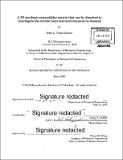| dc.contributor.advisor | Linda G. Griffith. | en_US |
| dc.contributor.author | Valdez Macias, Jorge L. (Jorge Luis) | en_US |
| dc.contributor.other | Massachusetts Institute of Technology. Department of Biological Engineering. | en_US |
| dc.date.accessioned | 2016-09-13T19:15:42Z | |
| dc.date.available | 2016-09-13T19:15:42Z | |
| dc.date.copyright | 2016 | en_US |
| dc.date.issued | 2016 | en_US |
| dc.identifier.uri | http://hdl.handle.net/1721.1/104235 | |
| dc.description | Thesis: Ph. D., Massachusetts Institute of Technology, Department of Biological Engineering, 2016. | en_US |
| dc.description | Cataloged from PDF version of thesis. | en_US |
| dc.description | Includes bibliographical references (pages 105-123). | en_US |
| dc.description.abstract | In vitro multi-cellular 3D cultures can provide tremendous insight into pathologies arising from dysregulation of extracellular communication by recapitulating key features of the microenvironment, such as ECM-cytokine interactions, spatially regulated cell-cell interactions, and matrix biophysical cues. Relevant 3D in vitro systems have been limited by the difficulty to assay the local microenvironment that cells directly experience, and by the lack of modularity of naturally-derived hydrogels such as Matrigel and collagen gels. Here, we exploit the modularity of synthetic hydrogels to overcome these limitations by designing a novel 3D culture system that can be locally and accurately interrogated. We begin by investigating the underlying principles directing morphogenesis in 3D synthetic PEG hydrogel cultures by screening the relevant parameter space - specifically, the intertwined relationship between adhesion and matrix degradation, the effect of cell-cell contacts, and cell-mediated matrix deposition. We use vasculogenesis of human iPSC-derived endothelial cells as a case study. Understanding vasculogenesis is a crucial requirement for engineering tissue models exceeding 100 gm due to nutrient diffusion limitations. Here we define microenvironment conditions that are permisive of the formation of 3D interconnected structures of iPSC endothelial cells in PEG hydrogels. Lastly, we adapted the synthetic hydrogels to enable local interrogation of the 3D microenvironment -a hitherto unavailable feature. Here we report a novel hydrogel system that can be used to both encapsulate complex co-cultures, and recover intact cells and local cytokines from the 3D matrix by repurposing a mutant of sortase A (SrtA). We demonstrate SrtA-mediated gel dissolution preserves important cell morphological features and can be used to measure recovered cytokines much more accurately compared to other proteolytic degradation methods. We observe discrepancies between the cytokine concentrations inside the gel and those in the culture medium. These local measurements reveal behaviors in response to an inflammatory stimulus that cannot be captured by monitoring only the cytokine concentrations in the medium. This system allows for better understanding of protein communication networks in relevant complex 3D multicellular cultures and can aid in identifying and testing targets in drug discovery and development. | en_US |
| dc.description.statementofresponsibility | by Jorge L. Valdez Macias. | en_US |
| dc.format.extent | 123 pages | en_US |
| dc.language.iso | eng | en_US |
| dc.publisher | Massachusetts Institute of Technology | en_US |
| dc.rights | MIT theses are protected by copyright. They may be viewed, downloaded, or printed from this source but further reproduction or distribution in any format is prohibited without written permission. | en_US |
| dc.rights.uri | http://dspace.mit.edu/handle/1721.1/7582 | en_US |
| dc.subject | Biological Engineering. | en_US |
| dc.title | A 3D synthetic extracellular matrix that can be dissolved to interrogate the cellular local microenvironment on demand | en_US |
| dc.type | Thesis | en_US |
| dc.description.degree | Ph. D. | en_US |
| dc.contributor.department | Massachusetts Institute of Technology. Department of Biological Engineering | |
| dc.identifier.oclc | 958143009 | en_US |
